UDL Framework Application: Contemporary Issues in Education
VerifiedAdded on 2023/06/11
|12
|2937
|408
Essay
AI Summary
This essay critically examines contemporary issues in education, focusing on a case study of a student with dyslexia. It discusses the student's strengths and weaknesses, and explores the Universal Design for Learning (UDL) framework as a means to address her learning needs. The essay explains the three core principles of UDL: multiple means of representation, action and expression, and engagement. Furthermore, it provides a detailed lesson plan applying the UDL framework to assist the student in mathematics, incorporating strategies such as multimedia resources, digital tools, and interactive teaching methods to enhance her learning experience and overcome the challenges posed by dyslexia. The lesson plan emphasizes personalized learning strategies, catering to the student's unique learning style and promoting active involvement in the learning process.

Running head: Critical essay on contemporary issues in education
Paraphrase This Document
Need a fresh take? Get an instant paraphrase of this document with our AI Paraphraser
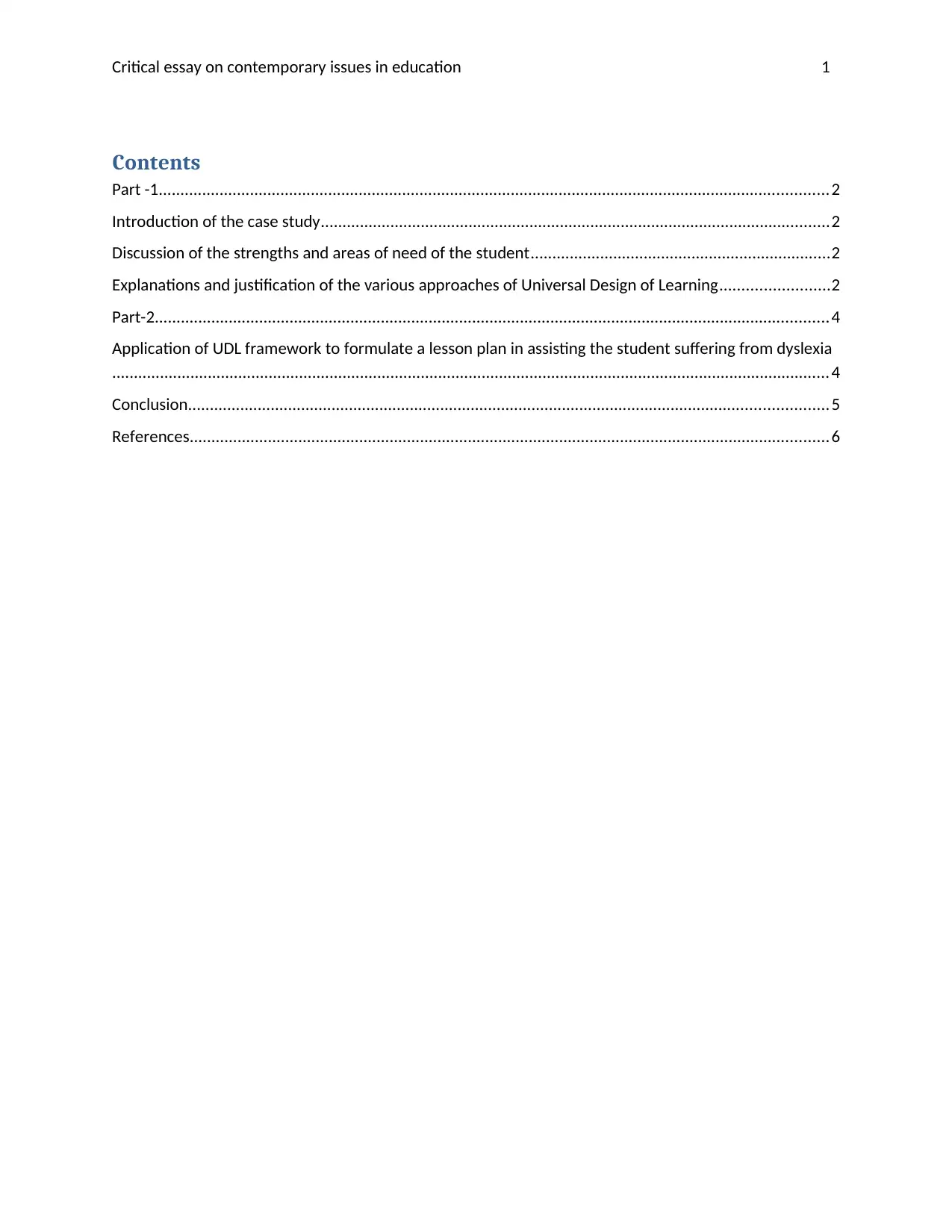
Critical essay on contemporary issues in education 1
Contents
Part -1..........................................................................................................................................................2
Introduction of the case study.....................................................................................................................2
Discussion of the strengths and areas of need of the student.....................................................................2
Explanations and justification of the various approaches of Universal Design of Learning.........................2
Part-2...........................................................................................................................................................4
Application of UDL framework to formulate a lesson plan in assisting the student suffering from dyslexia
.....................................................................................................................................................................4
Conclusion...................................................................................................................................................5
References...................................................................................................................................................6
Contents
Part -1..........................................................................................................................................................2
Introduction of the case study.....................................................................................................................2
Discussion of the strengths and areas of need of the student.....................................................................2
Explanations and justification of the various approaches of Universal Design of Learning.........................2
Part-2...........................................................................................................................................................4
Application of UDL framework to formulate a lesson plan in assisting the student suffering from dyslexia
.....................................................................................................................................................................4
Conclusion...................................................................................................................................................5
References...................................................................................................................................................6
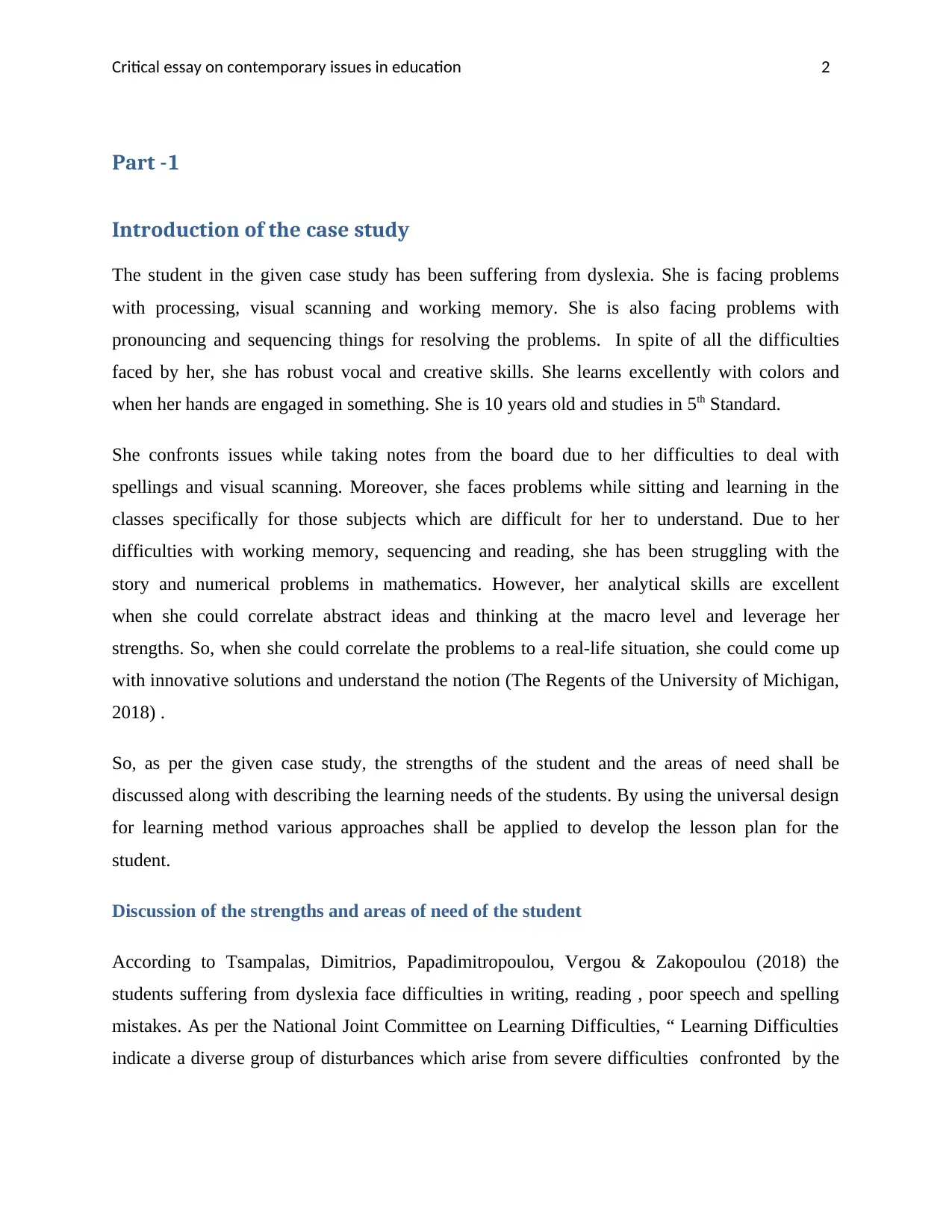
Critical essay on contemporary issues in education 2
Part -1
Introduction of the case study
The student in the given case study has been suffering from dyslexia. She is facing problems
with processing, visual scanning and working memory. She is also facing problems with
pronouncing and sequencing things for resolving the problems. In spite of all the difficulties
faced by her, she has robust vocal and creative skills. She learns excellently with colors and
when her hands are engaged in something. She is 10 years old and studies in 5th Standard.
She confronts issues while taking notes from the board due to her difficulties to deal with
spellings and visual scanning. Moreover, she faces problems while sitting and learning in the
classes specifically for those subjects which are difficult for her to understand. Due to her
difficulties with working memory, sequencing and reading, she has been struggling with the
story and numerical problems in mathematics. However, her analytical skills are excellent
when she could correlate abstract ideas and thinking at the macro level and leverage her
strengths. So, when she could correlate the problems to a real-life situation, she could come up
with innovative solutions and understand the notion (The Regents of the University of Michigan,
2018) .
So, as per the given case study, the strengths of the student and the areas of need shall be
discussed along with describing the learning needs of the students. By using the universal design
for learning method various approaches shall be applied to develop the lesson plan for the
student.
Discussion of the strengths and areas of need of the student
According to Tsampalas, Dimitrios, Papadimitropoulou, Vergou & Zakopoulou (2018) the
students suffering from dyslexia face difficulties in writing, reading , poor speech and spelling
mistakes. As per the National Joint Committee on Learning Difficulties, “ Learning Difficulties
indicate a diverse group of disturbances which arise from severe difficulties confronted by the
Part -1
Introduction of the case study
The student in the given case study has been suffering from dyslexia. She is facing problems
with processing, visual scanning and working memory. She is also facing problems with
pronouncing and sequencing things for resolving the problems. In spite of all the difficulties
faced by her, she has robust vocal and creative skills. She learns excellently with colors and
when her hands are engaged in something. She is 10 years old and studies in 5th Standard.
She confronts issues while taking notes from the board due to her difficulties to deal with
spellings and visual scanning. Moreover, she faces problems while sitting and learning in the
classes specifically for those subjects which are difficult for her to understand. Due to her
difficulties with working memory, sequencing and reading, she has been struggling with the
story and numerical problems in mathematics. However, her analytical skills are excellent
when she could correlate abstract ideas and thinking at the macro level and leverage her
strengths. So, when she could correlate the problems to a real-life situation, she could come up
with innovative solutions and understand the notion (The Regents of the University of Michigan,
2018) .
So, as per the given case study, the strengths of the student and the areas of need shall be
discussed along with describing the learning needs of the students. By using the universal design
for learning method various approaches shall be applied to develop the lesson plan for the
student.
Discussion of the strengths and areas of need of the student
According to Tsampalas, Dimitrios, Papadimitropoulou, Vergou & Zakopoulou (2018) the
students suffering from dyslexia face difficulties in writing, reading , poor speech and spelling
mistakes. As per the National Joint Committee on Learning Difficulties, “ Learning Difficulties
indicate a diverse group of disturbances which arise from severe difficulties confronted by the
⊘ This is a preview!⊘
Do you want full access?
Subscribe today to unlock all pages.

Trusted by 1+ million students worldwide
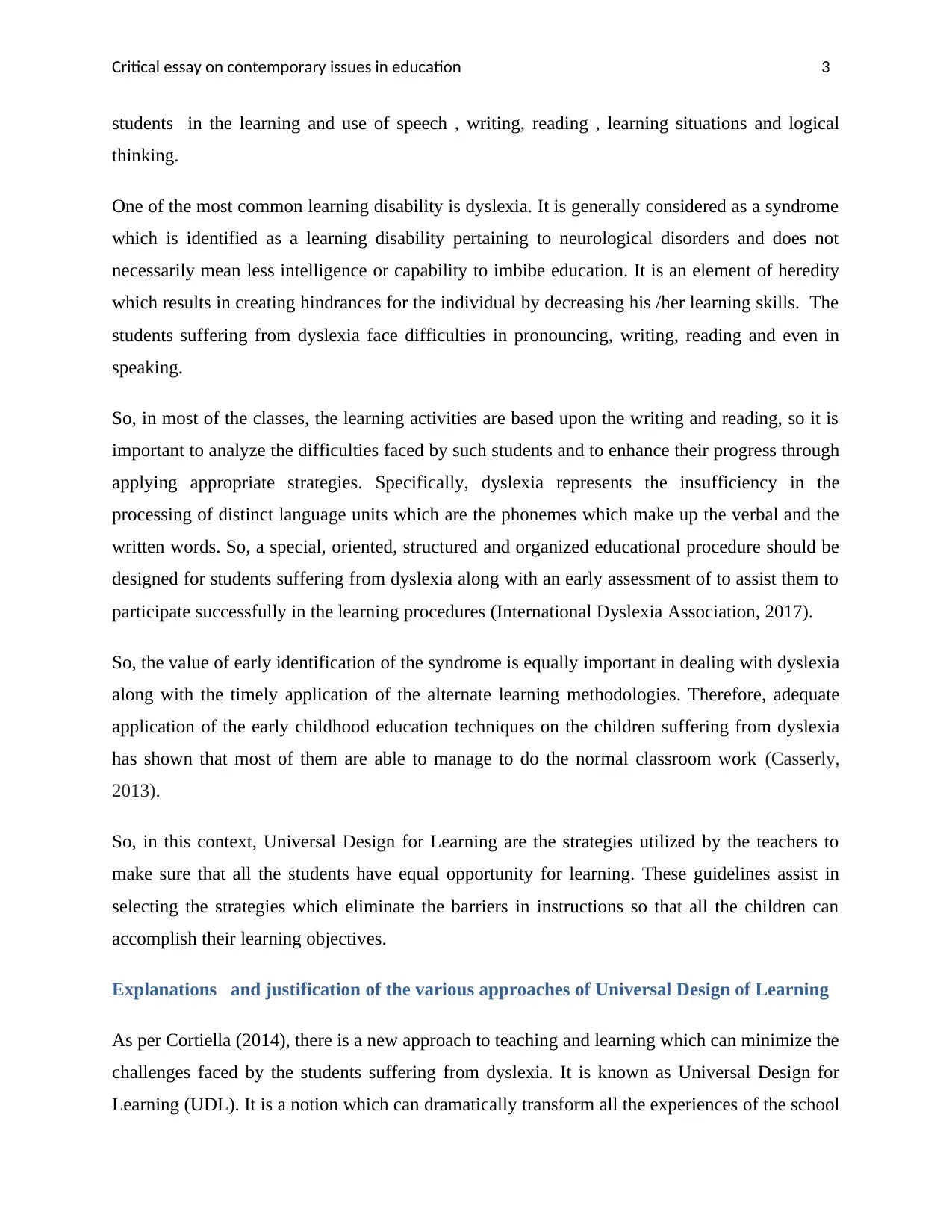
Critical essay on contemporary issues in education 3
students in the learning and use of speech , writing, reading , learning situations and logical
thinking.
One of the most common learning disability is dyslexia. It is generally considered as a syndrome
which is identified as a learning disability pertaining to neurological disorders and does not
necessarily mean less intelligence or capability to imbibe education. It is an element of heredity
which results in creating hindrances for the individual by decreasing his /her learning skills. The
students suffering from dyslexia face difficulties in pronouncing, writing, reading and even in
speaking.
So, in most of the classes, the learning activities are based upon the writing and reading, so it is
important to analyze the difficulties faced by such students and to enhance their progress through
applying appropriate strategies. Specifically, dyslexia represents the insufficiency in the
processing of distinct language units which are the phonemes which make up the verbal and the
written words. So, a special, oriented, structured and organized educational procedure should be
designed for students suffering from dyslexia along with an early assessment of to assist them to
participate successfully in the learning procedures (International Dyslexia Association, 2017).
So, the value of early identification of the syndrome is equally important in dealing with dyslexia
along with the timely application of the alternate learning methodologies. Therefore, adequate
application of the early childhood education techniques on the children suffering from dyslexia
has shown that most of them are able to manage to do the normal classroom work (Casserly,
2013).
So, in this context, Universal Design for Learning are the strategies utilized by the teachers to
make sure that all the students have equal opportunity for learning. These guidelines assist in
selecting the strategies which eliminate the barriers in instructions so that all the children can
accomplish their learning objectives.
Explanations and justification of the various approaches of Universal Design of Learning
As per Cortiella (2014), there is a new approach to teaching and learning which can minimize the
challenges faced by the students suffering from dyslexia. It is known as Universal Design for
Learning (UDL). It is a notion which can dramatically transform all the experiences of the school
students in the learning and use of speech , writing, reading , learning situations and logical
thinking.
One of the most common learning disability is dyslexia. It is generally considered as a syndrome
which is identified as a learning disability pertaining to neurological disorders and does not
necessarily mean less intelligence or capability to imbibe education. It is an element of heredity
which results in creating hindrances for the individual by decreasing his /her learning skills. The
students suffering from dyslexia face difficulties in pronouncing, writing, reading and even in
speaking.
So, in most of the classes, the learning activities are based upon the writing and reading, so it is
important to analyze the difficulties faced by such students and to enhance their progress through
applying appropriate strategies. Specifically, dyslexia represents the insufficiency in the
processing of distinct language units which are the phonemes which make up the verbal and the
written words. So, a special, oriented, structured and organized educational procedure should be
designed for students suffering from dyslexia along with an early assessment of to assist them to
participate successfully in the learning procedures (International Dyslexia Association, 2017).
So, the value of early identification of the syndrome is equally important in dealing with dyslexia
along with the timely application of the alternate learning methodologies. Therefore, adequate
application of the early childhood education techniques on the children suffering from dyslexia
has shown that most of them are able to manage to do the normal classroom work (Casserly,
2013).
So, in this context, Universal Design for Learning are the strategies utilized by the teachers to
make sure that all the students have equal opportunity for learning. These guidelines assist in
selecting the strategies which eliminate the barriers in instructions so that all the children can
accomplish their learning objectives.
Explanations and justification of the various approaches of Universal Design of Learning
As per Cortiella (2014), there is a new approach to teaching and learning which can minimize the
challenges faced by the students suffering from dyslexia. It is known as Universal Design for
Learning (UDL). It is a notion which can dramatically transform all the experiences of the school
Paraphrase This Document
Need a fresh take? Get an instant paraphrase of this document with our AI Paraphraser
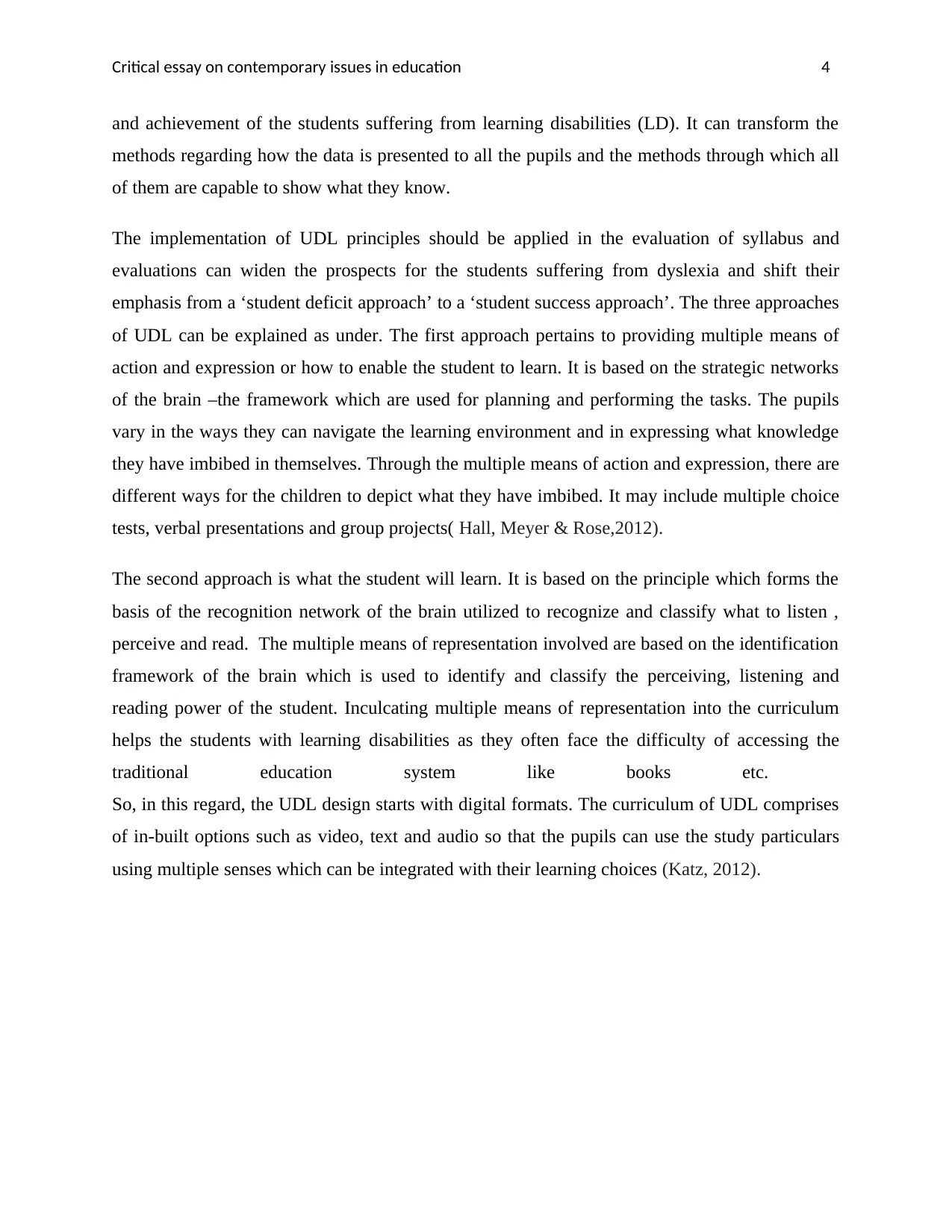
Critical essay on contemporary issues in education 4
and achievement of the students suffering from learning disabilities (LD). It can transform the
methods regarding how the data is presented to all the pupils and the methods through which all
of them are capable to show what they know.
The implementation of UDL principles should be applied in the evaluation of syllabus and
evaluations can widen the prospects for the students suffering from dyslexia and shift their
emphasis from a ‘student deficit approach’ to a ‘student success approach’. The three approaches
of UDL can be explained as under. The first approach pertains to providing multiple means of
action and expression or how to enable the student to learn. It is based on the strategic networks
of the brain –the framework which are used for planning and performing the tasks. The pupils
vary in the ways they can navigate the learning environment and in expressing what knowledge
they have imbibed in themselves. Through the multiple means of action and expression, there are
different ways for the children to depict what they have imbibed. It may include multiple choice
tests, verbal presentations and group projects( Hall, Meyer & Rose,2012).
The second approach is what the student will learn. It is based on the principle which forms the
basis of the recognition network of the brain utilized to recognize and classify what to listen ,
perceive and read. The multiple means of representation involved are based on the identification
framework of the brain which is used to identify and classify the perceiving, listening and
reading power of the student. Inculcating multiple means of representation into the curriculum
helps the students with learning disabilities as they often face the difficulty of accessing the
traditional education system like books etc.
So, in this regard, the UDL design starts with digital formats. The curriculum of UDL comprises
of in-built options such as video, text and audio so that the pupils can use the study particulars
using multiple senses which can be integrated with their learning choices (Katz, 2012).
and achievement of the students suffering from learning disabilities (LD). It can transform the
methods regarding how the data is presented to all the pupils and the methods through which all
of them are capable to show what they know.
The implementation of UDL principles should be applied in the evaluation of syllabus and
evaluations can widen the prospects for the students suffering from dyslexia and shift their
emphasis from a ‘student deficit approach’ to a ‘student success approach’. The three approaches
of UDL can be explained as under. The first approach pertains to providing multiple means of
action and expression or how to enable the student to learn. It is based on the strategic networks
of the brain –the framework which are used for planning and performing the tasks. The pupils
vary in the ways they can navigate the learning environment and in expressing what knowledge
they have imbibed in themselves. Through the multiple means of action and expression, there are
different ways for the children to depict what they have imbibed. It may include multiple choice
tests, verbal presentations and group projects( Hall, Meyer & Rose,2012).
The second approach is what the student will learn. It is based on the principle which forms the
basis of the recognition network of the brain utilized to recognize and classify what to listen ,
perceive and read. The multiple means of representation involved are based on the identification
framework of the brain which is used to identify and classify the perceiving, listening and
reading power of the student. Inculcating multiple means of representation into the curriculum
helps the students with learning disabilities as they often face the difficulty of accessing the
traditional education system like books etc.
So, in this regard, the UDL design starts with digital formats. The curriculum of UDL comprises
of in-built options such as video, text and audio so that the pupils can use the study particulars
using multiple senses which can be integrated with their learning choices (Katz, 2012).
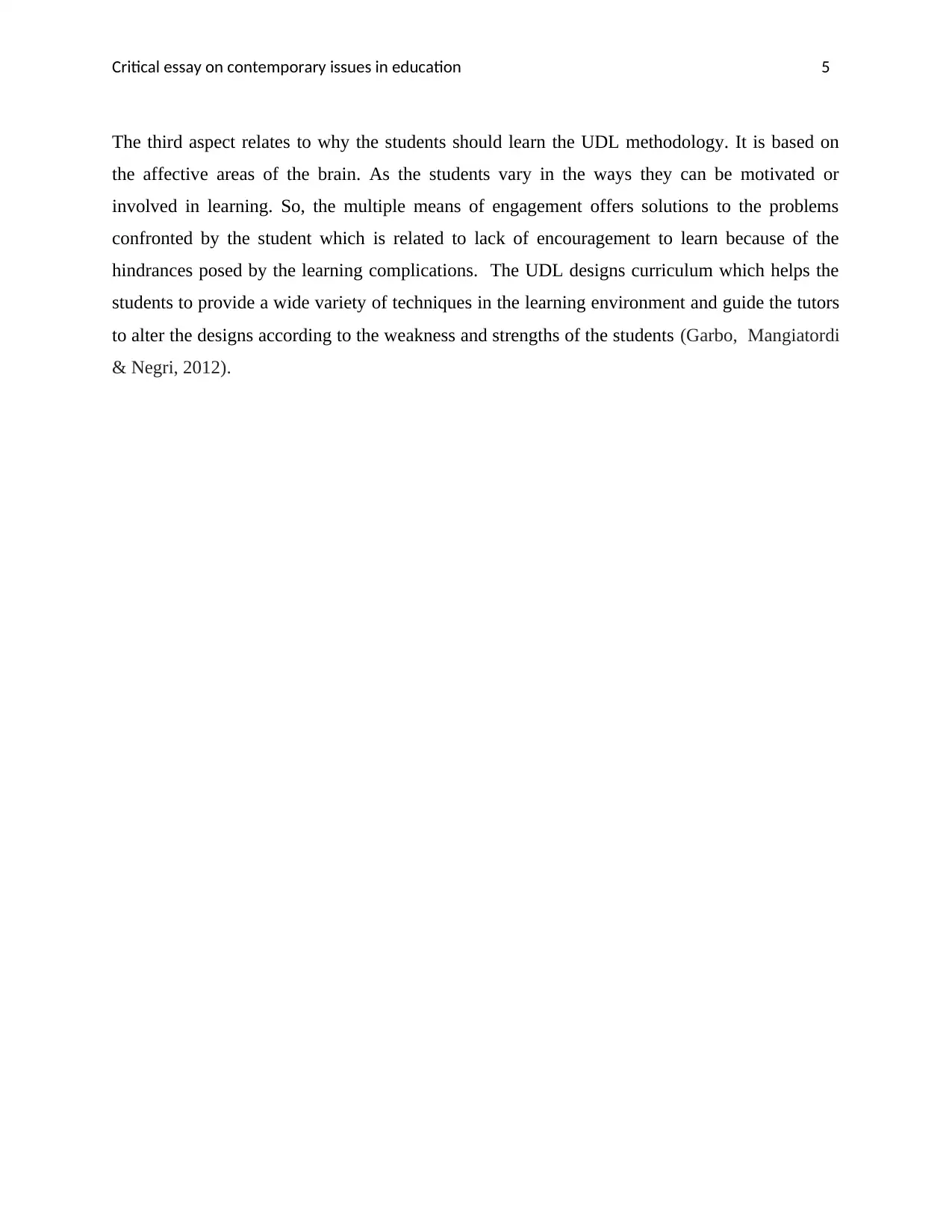
Critical essay on contemporary issues in education 5
The third aspect relates to why the students should learn the UDL methodology. It is based on
the affective areas of the brain. As the students vary in the ways they can be motivated or
involved in learning. So, the multiple means of engagement offers solutions to the problems
confronted by the student which is related to lack of encouragement to learn because of the
hindrances posed by the learning complications. The UDL designs curriculum which helps the
students to provide a wide variety of techniques in the learning environment and guide the tutors
to alter the designs according to the weakness and strengths of the students (Garbo, Mangiatordi
& Negri, 2012).
The third aspect relates to why the students should learn the UDL methodology. It is based on
the affective areas of the brain. As the students vary in the ways they can be motivated or
involved in learning. So, the multiple means of engagement offers solutions to the problems
confronted by the student which is related to lack of encouragement to learn because of the
hindrances posed by the learning complications. The UDL designs curriculum which helps the
students to provide a wide variety of techniques in the learning environment and guide the tutors
to alter the designs according to the weakness and strengths of the students (Garbo, Mangiatordi
& Negri, 2012).
⊘ This is a preview!⊘
Do you want full access?
Subscribe today to unlock all pages.

Trusted by 1+ million students worldwide
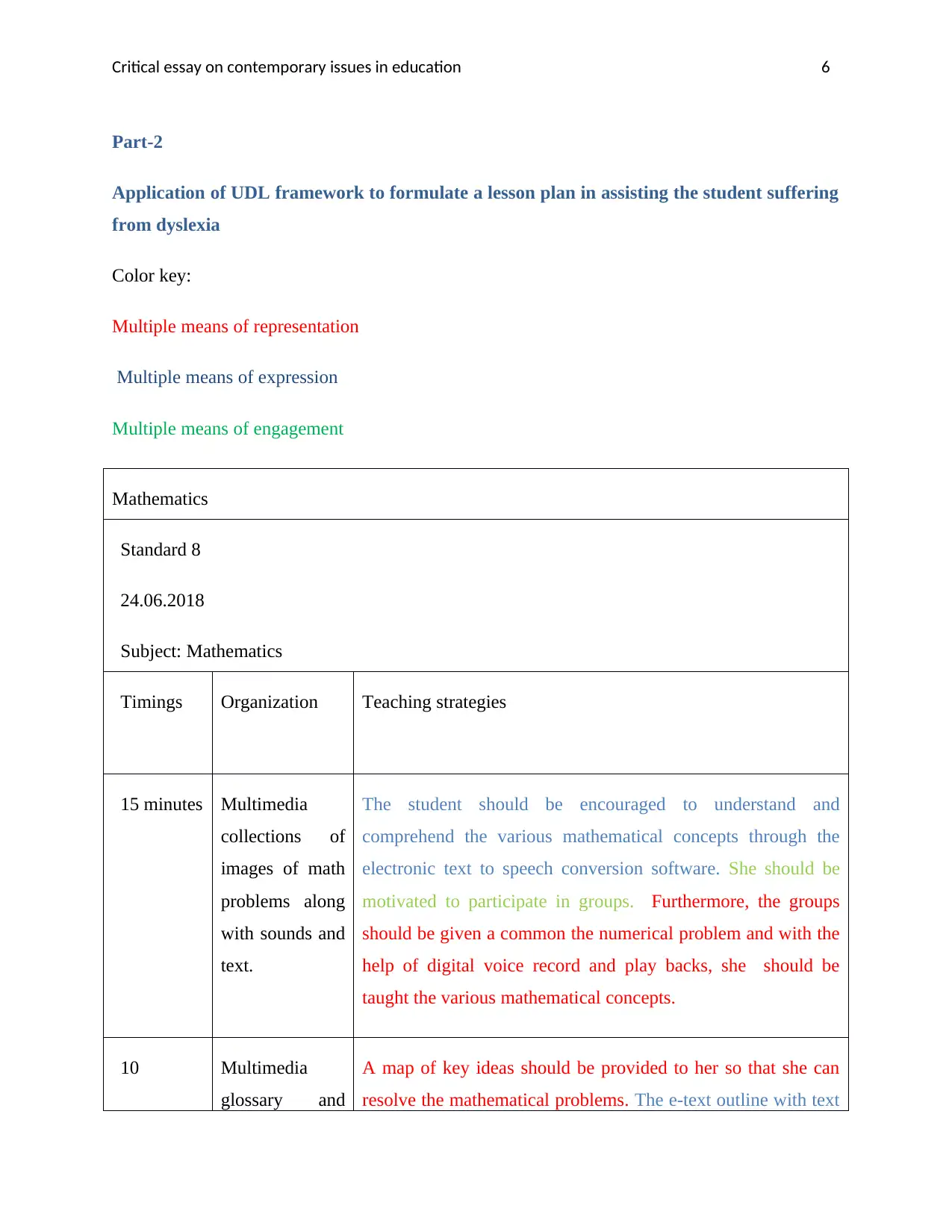
Critical essay on contemporary issues in education 6
Part-2
Application of UDL framework to formulate a lesson plan in assisting the student suffering
from dyslexia
Color key:
Multiple means of representation
Multiple means of expression
Multiple means of engagement
Mathematics
Standard 8
24.06.2018
Subject: Mathematics
Timings Organization Teaching strategies
15 minutes Multimedia
collections of
images of math
problems along
with sounds and
text.
The student should be encouraged to understand and
comprehend the various mathematical concepts through the
electronic text to speech conversion software. She should be
motivated to participate in groups. Furthermore, the groups
should be given a common the numerical problem and with the
help of digital voice record and play backs, she should be
taught the various mathematical concepts.
10 Multimedia
glossary and
A map of key ideas should be provided to her so that she can
resolve the mathematical problems. The e-text outline with text
Part-2
Application of UDL framework to formulate a lesson plan in assisting the student suffering
from dyslexia
Color key:
Multiple means of representation
Multiple means of expression
Multiple means of engagement
Mathematics
Standard 8
24.06.2018
Subject: Mathematics
Timings Organization Teaching strategies
15 minutes Multimedia
collections of
images of math
problems along
with sounds and
text.
The student should be encouraged to understand and
comprehend the various mathematical concepts through the
electronic text to speech conversion software. She should be
motivated to participate in groups. Furthermore, the groups
should be given a common the numerical problem and with the
help of digital voice record and play backs, she should be
taught the various mathematical concepts.
10 Multimedia
glossary and
A map of key ideas should be provided to her so that she can
resolve the mathematical problems. The e-text outline with text
Paraphrase This Document
Need a fresh take? Get an instant paraphrase of this document with our AI Paraphraser

Critical essay on contemporary issues in education 7
Minutes cross media
alternatives.
to speech conversion software can assist her to access and
understand the problems and their solutions.
With the help of multimedia recording, digital cameras and
image digitizing, the teachers can help the student to learn the
concepts and find ways to solve the numerical and word
problems of mathematics (Al Hazmi & Ahmad,2018).
5 minutes Digital
photographs
with recorded
sounds and
stories depicting
the outline of
the project.
She can also be taught by providing them web page with
collection of images. The mathematical problems can also be
taught by media banks –images, sounds, animations and videos
and through web site design techniques such as home page and
dream weaver (ASCD, 2018).
15 minutes Templates to
structure the
work of the
students.
The web pages with attached sources for library research along
with a collection of online resources which are linked to outline
of the key project parts. The collections of completed projects,
work of the experts and teacher-generated examples should be
depicted through web links.
The multimedia collections such as stories, facts and data as
stated in the project can be depicted through online templates.
The student should be encouraged to express what she has
understood with the help of multimedia presentation tools.
Minutes cross media
alternatives.
to speech conversion software can assist her to access and
understand the problems and their solutions.
With the help of multimedia recording, digital cameras and
image digitizing, the teachers can help the student to learn the
concepts and find ways to solve the numerical and word
problems of mathematics (Al Hazmi & Ahmad,2018).
5 minutes Digital
photographs
with recorded
sounds and
stories depicting
the outline of
the project.
She can also be taught by providing them web page with
collection of images. The mathematical problems can also be
taught by media banks –images, sounds, animations and videos
and through web site design techniques such as home page and
dream weaver (ASCD, 2018).
15 minutes Templates to
structure the
work of the
students.
The web pages with attached sources for library research along
with a collection of online resources which are linked to outline
of the key project parts. The collections of completed projects,
work of the experts and teacher-generated examples should be
depicted through web links.
The multimedia collections such as stories, facts and data as
stated in the project can be depicted through online templates.
The student should be encouraged to express what she has
understood with the help of multimedia presentation tools.
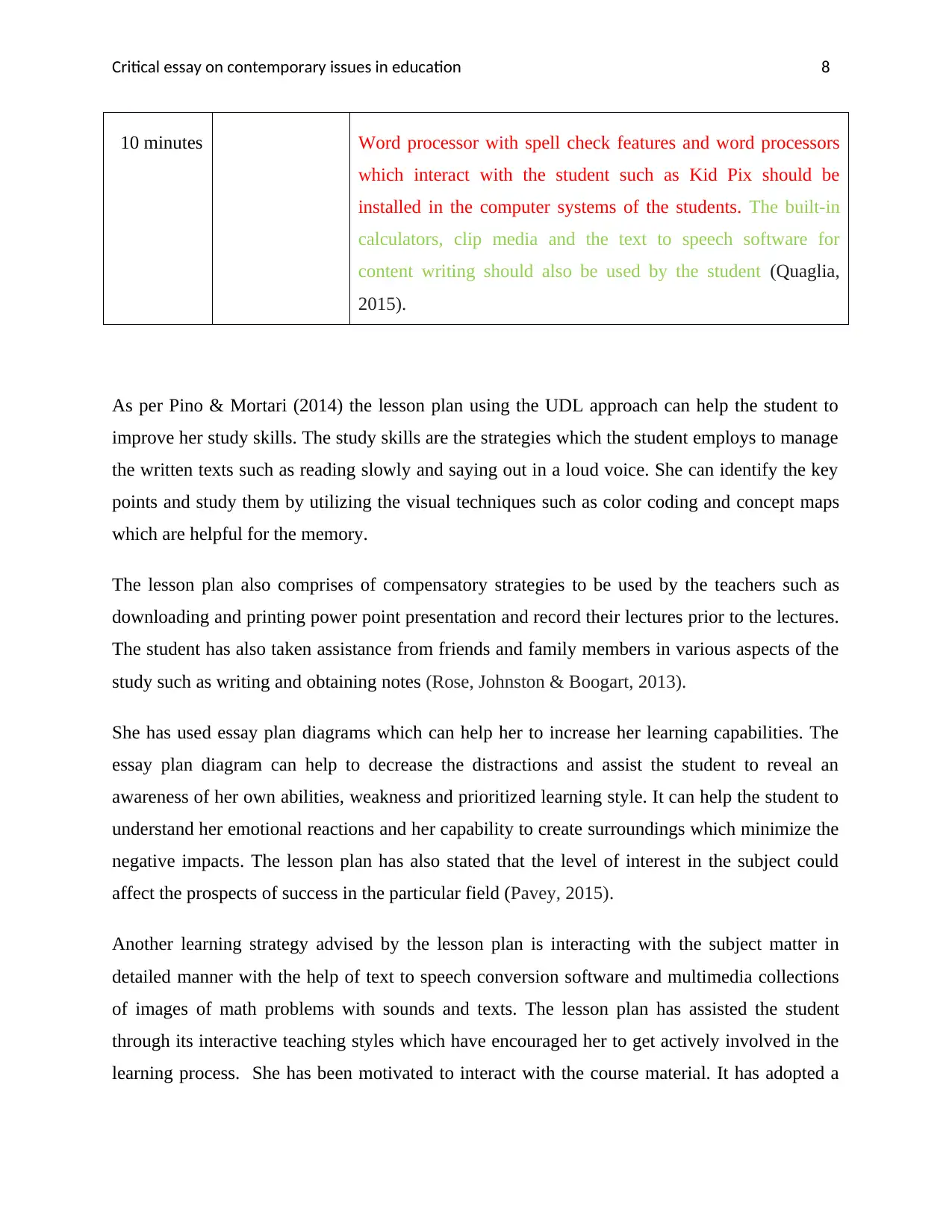
Critical essay on contemporary issues in education 8
10 minutes Word processor with spell check features and word processors
which interact with the student such as Kid Pix should be
installed in the computer systems of the students. The built-in
calculators, clip media and the text to speech software for
content writing should also be used by the student (Quaglia,
2015).
As per Pino & Mortari (2014) the lesson plan using the UDL approach can help the student to
improve her study skills. The study skills are the strategies which the student employs to manage
the written texts such as reading slowly and saying out in a loud voice. She can identify the key
points and study them by utilizing the visual techniques such as color coding and concept maps
which are helpful for the memory.
The lesson plan also comprises of compensatory strategies to be used by the teachers such as
downloading and printing power point presentation and record their lectures prior to the lectures.
The student has also taken assistance from friends and family members in various aspects of the
study such as writing and obtaining notes (Rose, Johnston & Boogart, 2013).
She has used essay plan diagrams which can help her to increase her learning capabilities. The
essay plan diagram can help to decrease the distractions and assist the student to reveal an
awareness of her own abilities, weakness and prioritized learning style. It can help the student to
understand her emotional reactions and her capability to create surroundings which minimize the
negative impacts. The lesson plan has also stated that the level of interest in the subject could
affect the prospects of success in the particular field (Pavey, 2015).
Another learning strategy advised by the lesson plan is interacting with the subject matter in
detailed manner with the help of text to speech conversion software and multimedia collections
of images of math problems with sounds and texts. The lesson plan has assisted the student
through its interactive teaching styles which have encouraged her to get actively involved in the
learning process. She has been motivated to interact with the course material. It has adopted a
10 minutes Word processor with spell check features and word processors
which interact with the student such as Kid Pix should be
installed in the computer systems of the students. The built-in
calculators, clip media and the text to speech software for
content writing should also be used by the student (Quaglia,
2015).
As per Pino & Mortari (2014) the lesson plan using the UDL approach can help the student to
improve her study skills. The study skills are the strategies which the student employs to manage
the written texts such as reading slowly and saying out in a loud voice. She can identify the key
points and study them by utilizing the visual techniques such as color coding and concept maps
which are helpful for the memory.
The lesson plan also comprises of compensatory strategies to be used by the teachers such as
downloading and printing power point presentation and record their lectures prior to the lectures.
The student has also taken assistance from friends and family members in various aspects of the
study such as writing and obtaining notes (Rose, Johnston & Boogart, 2013).
She has used essay plan diagrams which can help her to increase her learning capabilities. The
essay plan diagram can help to decrease the distractions and assist the student to reveal an
awareness of her own abilities, weakness and prioritized learning style. It can help the student to
understand her emotional reactions and her capability to create surroundings which minimize the
negative impacts. The lesson plan has also stated that the level of interest in the subject could
affect the prospects of success in the particular field (Pavey, 2015).
Another learning strategy advised by the lesson plan is interacting with the subject matter in
detailed manner with the help of text to speech conversion software and multimedia collections
of images of math problems with sounds and texts. The lesson plan has assisted the student
through its interactive teaching styles which have encouraged her to get actively involved in the
learning process. She has been motivated to interact with the course material. It has adopted a
⊘ This is a preview!⊘
Do you want full access?
Subscribe today to unlock all pages.

Trusted by 1+ million students worldwide

Critical essay on contemporary issues in education 9
student-centered style which analyses the student’s background knowledge about the subject and
makes her accountable to overcome dyslexia (Smith, Leconte & Vitelli, 2012).
The lesson plan has empowered the student to speak in her own voice and use the language and
vocabulary of her own convenience. The graphical representation of the subject material and
formative feedback of the student have proved to be useful in enhancing her learning process.
So, with the help of UDL learning model, the dyslexic pupils can be encouraged to overcome
their weakness by using their strengths (Strimple, 2013).
Conclusion
Hence, to conclude, it can be said that UDL learning model can prove to be a useful tool for
responding to the challenges faced by the dyslexic students in inclusive settings. They provide
personal support and adjustments so that the students can learn as per their own convenience. It
assists the teachers to formulate the courses in flexible and multi-layered ways so that manifold
formats of delivery of teaching material can fulfill the necessities of the various pupils. It also
helps in designing personal curriculum as per the needs of the students who face further
difficulties and addresses to their special needs.
student-centered style which analyses the student’s background knowledge about the subject and
makes her accountable to overcome dyslexia (Smith, Leconte & Vitelli, 2012).
The lesson plan has empowered the student to speak in her own voice and use the language and
vocabulary of her own convenience. The graphical representation of the subject material and
formative feedback of the student have proved to be useful in enhancing her learning process.
So, with the help of UDL learning model, the dyslexic pupils can be encouraged to overcome
their weakness by using their strengths (Strimple, 2013).
Conclusion
Hence, to conclude, it can be said that UDL learning model can prove to be a useful tool for
responding to the challenges faced by the dyslexic students in inclusive settings. They provide
personal support and adjustments so that the students can learn as per their own convenience. It
assists the teachers to formulate the courses in flexible and multi-layered ways so that manifold
formats of delivery of teaching material can fulfill the necessities of the various pupils. It also
helps in designing personal curriculum as per the needs of the students who face further
difficulties and addresses to their special needs.
Paraphrase This Document
Need a fresh take? Get an instant paraphrase of this document with our AI Paraphraser
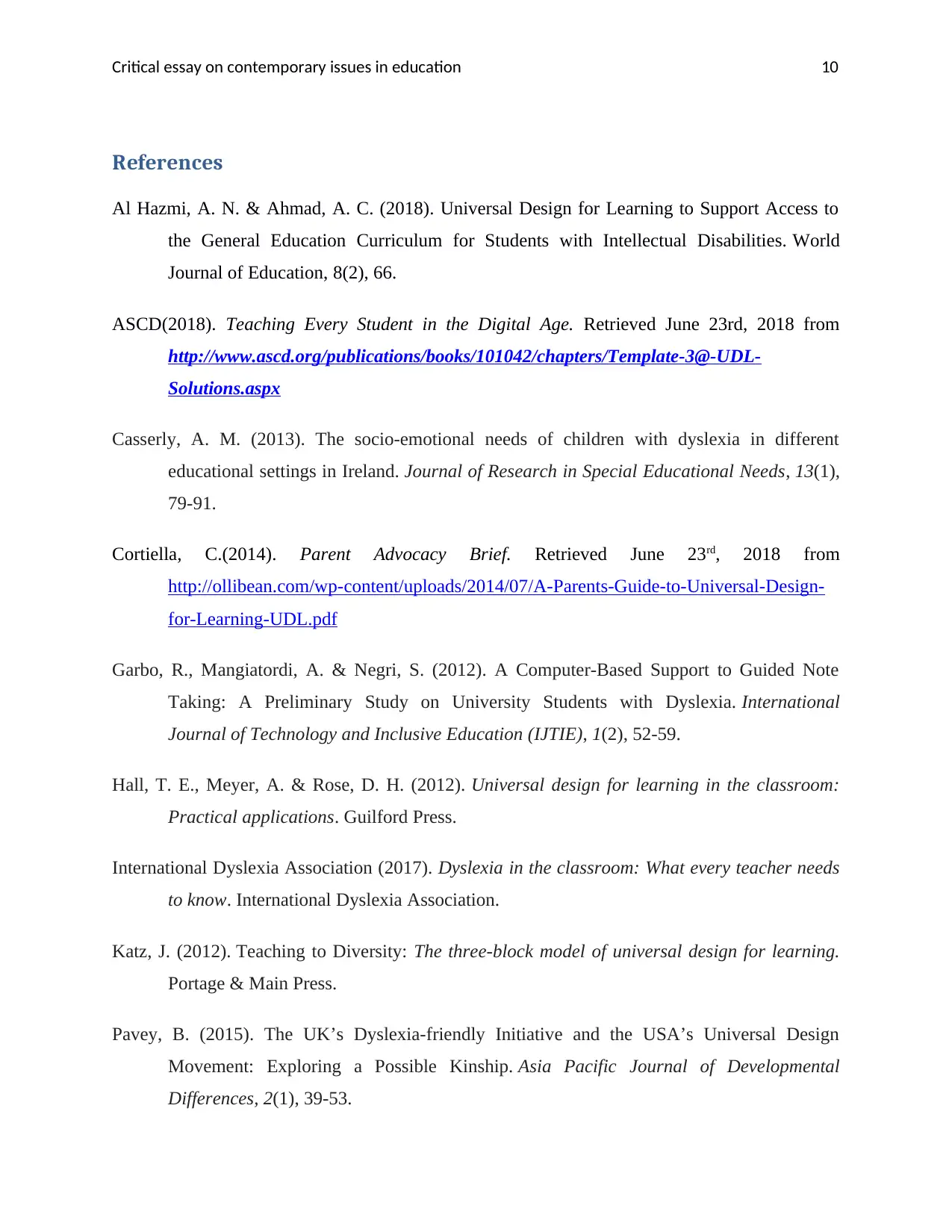
Critical essay on contemporary issues in education 10
References
Al Hazmi, A. N. & Ahmad, A. C. (2018). Universal Design for Learning to Support Access to
the General Education Curriculum for Students with Intellectual Disabilities. World
Journal of Education, 8(2), 66.
ASCD(2018). Teaching Every Student in the Digital Age. Retrieved June 23rd, 2018 from
http://www.ascd.org/publications/books/101042/chapters/Template-3@-UDL-
Solutions.aspx
Casserly, A. M. (2013). The socio‐emotional needs of children with dyslexia in different
educational settings in Ireland. Journal of Research in Special Educational Needs, 13(1),
79-91.
Cortiella, C.(2014). Parent Advocacy Brief. Retrieved June 23rd, 2018 from
http://ollibean.com/wp-content/uploads/2014/07/A-Parents-Guide-to-Universal-Design-
for-Learning-UDL.pdf
Garbo, R., Mangiatordi, A. & Negri, S. (2012). A Computer-Based Support to Guided Note
Taking: A Preliminary Study on University Students with Dyslexia. International
Journal of Technology and Inclusive Education (IJTIE), 1(2), 52-59.
Hall, T. E., Meyer, A. & Rose, D. H. (2012). Universal design for learning in the classroom:
Practical applications. Guilford Press.
International Dyslexia Association (2017). Dyslexia in the classroom: What every teacher needs
to know. International Dyslexia Association.
Katz, J. (2012). Teaching to Diversity: The three-block model of universal design for learning.
Portage & Main Press.
Pavey, B. (2015). The UK’s Dyslexia-friendly Initiative and the USA’s Universal Design
Movement: Exploring a Possible Kinship. Asia Pacific Journal of Developmental
Differences, 2(1), 39-53.
References
Al Hazmi, A. N. & Ahmad, A. C. (2018). Universal Design for Learning to Support Access to
the General Education Curriculum for Students with Intellectual Disabilities. World
Journal of Education, 8(2), 66.
ASCD(2018). Teaching Every Student in the Digital Age. Retrieved June 23rd, 2018 from
http://www.ascd.org/publications/books/101042/chapters/Template-3@-UDL-
Solutions.aspx
Casserly, A. M. (2013). The socio‐emotional needs of children with dyslexia in different
educational settings in Ireland. Journal of Research in Special Educational Needs, 13(1),
79-91.
Cortiella, C.(2014). Parent Advocacy Brief. Retrieved June 23rd, 2018 from
http://ollibean.com/wp-content/uploads/2014/07/A-Parents-Guide-to-Universal-Design-
for-Learning-UDL.pdf
Garbo, R., Mangiatordi, A. & Negri, S. (2012). A Computer-Based Support to Guided Note
Taking: A Preliminary Study on University Students with Dyslexia. International
Journal of Technology and Inclusive Education (IJTIE), 1(2), 52-59.
Hall, T. E., Meyer, A. & Rose, D. H. (2012). Universal design for learning in the classroom:
Practical applications. Guilford Press.
International Dyslexia Association (2017). Dyslexia in the classroom: What every teacher needs
to know. International Dyslexia Association.
Katz, J. (2012). Teaching to Diversity: The three-block model of universal design for learning.
Portage & Main Press.
Pavey, B. (2015). The UK’s Dyslexia-friendly Initiative and the USA’s Universal Design
Movement: Exploring a Possible Kinship. Asia Pacific Journal of Developmental
Differences, 2(1), 39-53.
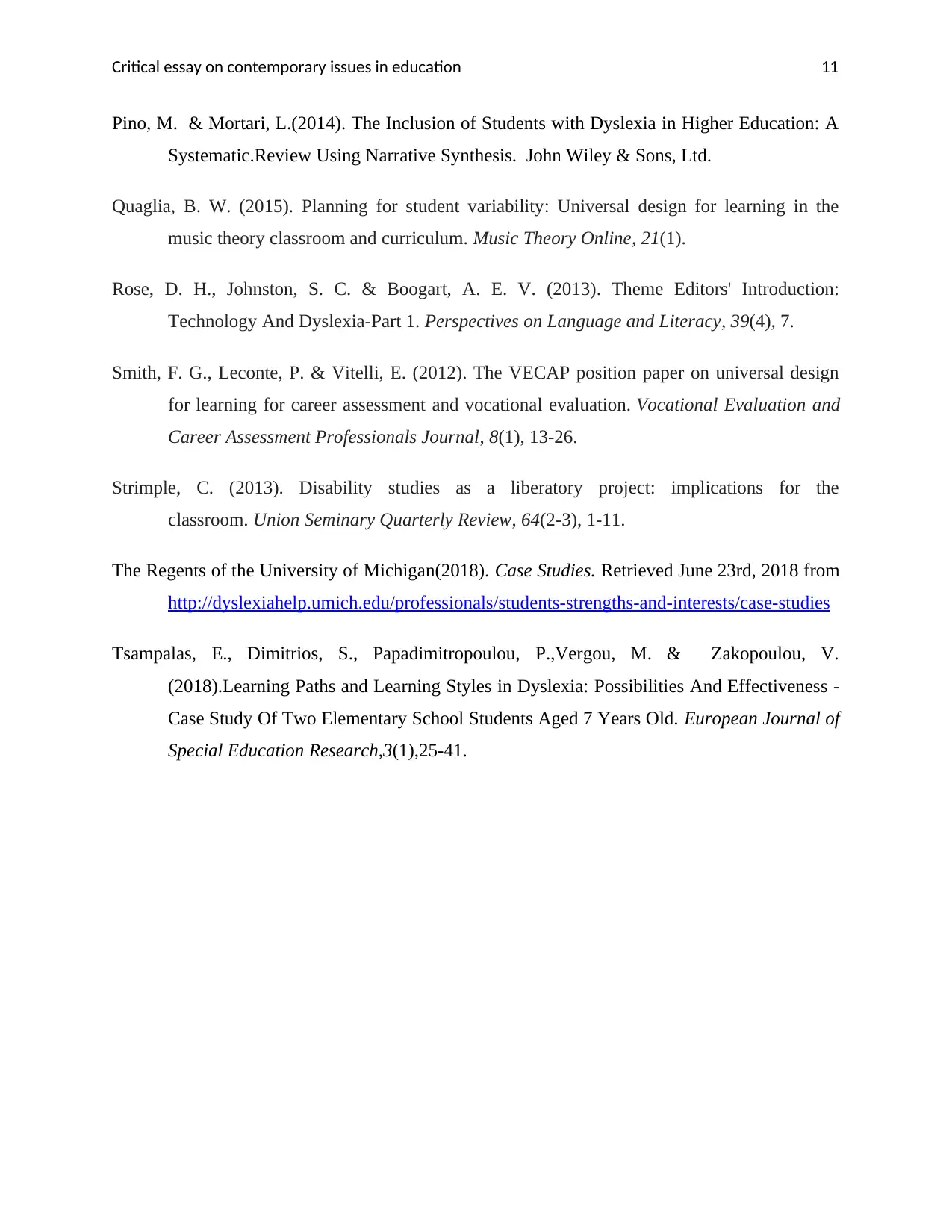
Critical essay on contemporary issues in education 11
Pino, M. & Mortari, L.(2014). The Inclusion of Students with Dyslexia in Higher Education: A
Systematic.Review Using Narrative Synthesis. John Wiley & Sons, Ltd.
Quaglia, B. W. (2015). Planning for student variability: Universal design for learning in the
music theory classroom and curriculum. Music Theory Online, 21(1).
Rose, D. H., Johnston, S. C. & Boogart, A. E. V. (2013). Theme Editors' Introduction:
Technology And Dyslexia-Part 1. Perspectives on Language and Literacy, 39(4), 7.
Smith, F. G., Leconte, P. & Vitelli, E. (2012). The VECAP position paper on universal design
for learning for career assessment and vocational evaluation. Vocational Evaluation and
Career Assessment Professionals Journal, 8(1), 13-26.
Strimple, C. (2013). Disability studies as a liberatory project: implications for the
classroom. Union Seminary Quarterly Review, 64(2-3), 1-11.
The Regents of the University of Michigan(2018). Case Studies. Retrieved June 23rd, 2018 from
http://dyslexiahelp.umich.edu/professionals/students-strengths-and-interests/case-studies
Tsampalas, E., Dimitrios, S., Papadimitropoulou, P.,Vergou, M. & Zakopoulou, V.
(2018).Learning Paths and Learning Styles in Dyslexia: Possibilities And Effectiveness -
Case Study Of Two Elementary School Students Aged 7 Years Old. European Journal of
Special Education Research,3(1),25-41.
Pino, M. & Mortari, L.(2014). The Inclusion of Students with Dyslexia in Higher Education: A
Systematic.Review Using Narrative Synthesis. John Wiley & Sons, Ltd.
Quaglia, B. W. (2015). Planning for student variability: Universal design for learning in the
music theory classroom and curriculum. Music Theory Online, 21(1).
Rose, D. H., Johnston, S. C. & Boogart, A. E. V. (2013). Theme Editors' Introduction:
Technology And Dyslexia-Part 1. Perspectives on Language and Literacy, 39(4), 7.
Smith, F. G., Leconte, P. & Vitelli, E. (2012). The VECAP position paper on universal design
for learning for career assessment and vocational evaluation. Vocational Evaluation and
Career Assessment Professionals Journal, 8(1), 13-26.
Strimple, C. (2013). Disability studies as a liberatory project: implications for the
classroom. Union Seminary Quarterly Review, 64(2-3), 1-11.
The Regents of the University of Michigan(2018). Case Studies. Retrieved June 23rd, 2018 from
http://dyslexiahelp.umich.edu/professionals/students-strengths-and-interests/case-studies
Tsampalas, E., Dimitrios, S., Papadimitropoulou, P.,Vergou, M. & Zakopoulou, V.
(2018).Learning Paths and Learning Styles in Dyslexia: Possibilities And Effectiveness -
Case Study Of Two Elementary School Students Aged 7 Years Old. European Journal of
Special Education Research,3(1),25-41.
⊘ This is a preview!⊘
Do you want full access?
Subscribe today to unlock all pages.

Trusted by 1+ million students worldwide
1 out of 12
Related Documents
Your All-in-One AI-Powered Toolkit for Academic Success.
+13062052269
info@desklib.com
Available 24*7 on WhatsApp / Email
![[object Object]](/_next/static/media/star-bottom.7253800d.svg)
Unlock your academic potential
Copyright © 2020–2025 A2Z Services. All Rights Reserved. Developed and managed by ZUCOL.





